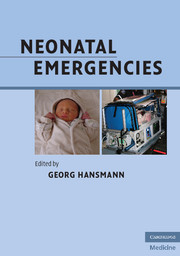Book contents
- Frontmatter
- Contents
- List of contributors
- Foreword (1)
- Foreword (2)
- Preface
- Acknowledgments
- Section 1 Organization of neonatal transport
- Section 2 Basics in cardiopulmonary resuscitation of newborn infants
- Basic equipment setup for initial neonatal care and resuscitation
- Drugs for neonatal emergencies
- Postnatal cardiopulmonary adaptation
- ABC Techniques and Procedures
- Sunctioning
- Stimulation, oxygen supplementation, bag-and-mask ventilation (M-PPV), pharyngeal/bi-nasal CPAP, and pharyngeal positive pressure ventilation
- Endotracheal intubation and gastric tube placement
- Laryngeal mask airway (LMA)
- Chest compressions
- Peripheral venous access
- Umbilical vein/artery catheterization (UVC, UAC)
- Central venous access (internal jugular vein)
- Intraosseous access
- Cord clamping
- Management of high-risk infants in the delivery room
- Monitoring in the delivery room and during neonatal transport
- Hygiene in the delivery room and during neonatal transport (infection control)
- When to call a pediatrician to the delivery room
- Checklist for the postnatal treatment of newborn infants
- Assigning individual duties in the delivery room
- Clinical assessment of the newborn infant
- Cardiopulmonary resuscitation of newborn infants at birth
- Volume therapy and sodium bicarbonate supplementation in preterm and term newborn infants
- Absolute and relative indications for neonatal transport and NICU admission
- Communication with mother and father
- Coordinating neonatal transport and patient sign-out to the NICU team
- Documentation and feedback after neonatal emergency transport
- Ethics in neonatal intensive care
- Perinatal images of preterm and term infants
- Mechanical ventilation of the neonate
- Questions for review (basics)
- References (Section 2)
- Section 3 Classic and rare scenarios in the neonatal period
- Section 4 Transport
- Section 5 Appendix
- Index
- Plate section
Monitoring in the delivery room and during neonatal transport
from Section 2 - Basics in cardiopulmonary resuscitation of newborn infants
Published online by Cambridge University Press: 05 March 2012
- Frontmatter
- Contents
- List of contributors
- Foreword (1)
- Foreword (2)
- Preface
- Acknowledgments
- Section 1 Organization of neonatal transport
- Section 2 Basics in cardiopulmonary resuscitation of newborn infants
- Basic equipment setup for initial neonatal care and resuscitation
- Drugs for neonatal emergencies
- Postnatal cardiopulmonary adaptation
- ABC Techniques and Procedures
- Sunctioning
- Stimulation, oxygen supplementation, bag-and-mask ventilation (M-PPV), pharyngeal/bi-nasal CPAP, and pharyngeal positive pressure ventilation
- Endotracheal intubation and gastric tube placement
- Laryngeal mask airway (LMA)
- Chest compressions
- Peripheral venous access
- Umbilical vein/artery catheterization (UVC, UAC)
- Central venous access (internal jugular vein)
- Intraosseous access
- Cord clamping
- Management of high-risk infants in the delivery room
- Monitoring in the delivery room and during neonatal transport
- Hygiene in the delivery room and during neonatal transport (infection control)
- When to call a pediatrician to the delivery room
- Checklist for the postnatal treatment of newborn infants
- Assigning individual duties in the delivery room
- Clinical assessment of the newborn infant
- Cardiopulmonary resuscitation of newborn infants at birth
- Volume therapy and sodium bicarbonate supplementation in preterm and term newborn infants
- Absolute and relative indications for neonatal transport and NICU admission
- Communication with mother and father
- Coordinating neonatal transport and patient sign-out to the NICU team
- Documentation and feedback after neonatal emergency transport
- Ethics in neonatal intensive care
- Perinatal images of preterm and term infants
- Mechanical ventilation of the neonate
- Questions for review (basics)
- References (Section 2)
- Section 3 Classic and rare scenarios in the neonatal period
- Section 4 Transport
- Section 5 Appendix
- Index
- Plate section
Summary
! Pulse oximetry (SpO2, HR) is part of standard monitoring in the delivery room and during transport.
Heart rate (HR)
Measurement of the HR (at the umbilical cord, by auscultation, by pulse oximetry or ECG) is the most objective indicator of: (1) the newborn's clinical condition, (2) the need for PPV (HR <100 bpm) or chest compressions (HR <60 bpm), and (3) a good response to one's resuscitation efforts (e.g., rise in HR after successful mask-PPV or endotracheal intubation plus PPV). The HR should correlate with the pulse palpated (brachial or femoral artery).
Pulse oximetry (SpO2, HR)
An analysis of six studies aimed at estimating the “normal SpO2 in newborn infants in the first minutes of life” revealed that in term and near-term infants a (pre- or postductal) SpO2 of 90% was reached at about 5 minutes of life. The SpO2 at 1 min of life ranged from 40% to 70%. SpO2 was generally lower in preterm infants and in those delivered by cesarean section. Postductal SpO2 (feet) was 7–10 percentage points lower than preductal SpO2 30.
Heart rate and SpO2 tracings are more easily picked up when the transducer is placed at the hands rather than the feet (perfusion more often impaired in the feet). If the neonate shows no early signs of dyspnea (nasal flaring, retractions at about 5–15 min postnatally) and no longer needs supplemental oxygen, then the baby should be wrapped up warmly and laid on the mother's chest (if necessary, monitored with a pulse oximeter). The 10-min Apgar score and a 30-min postnatal blood glucose and blood gas analysis can be obtained thereafter.
- Type
- Chapter
- Information
- Neonatal Emergencies , pp. 131 - 132Publisher: Cambridge University PressPrint publication year: 2009



